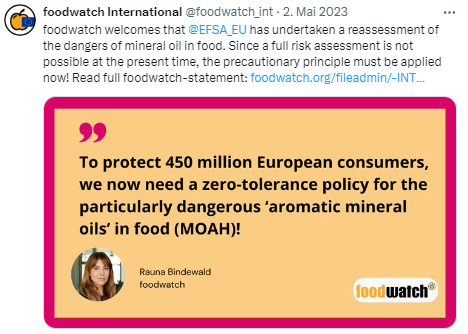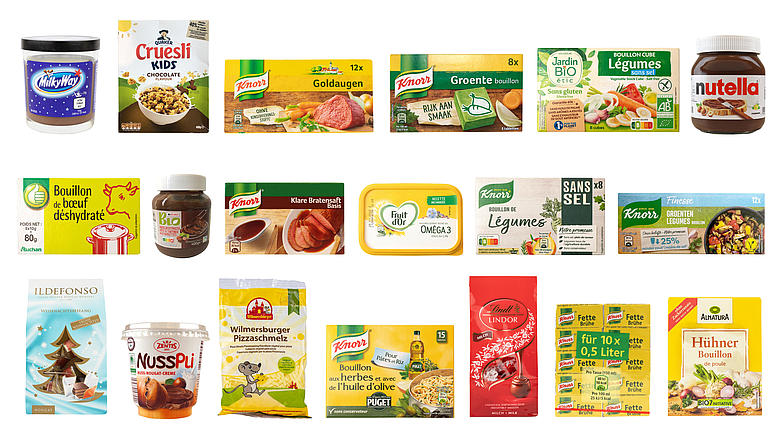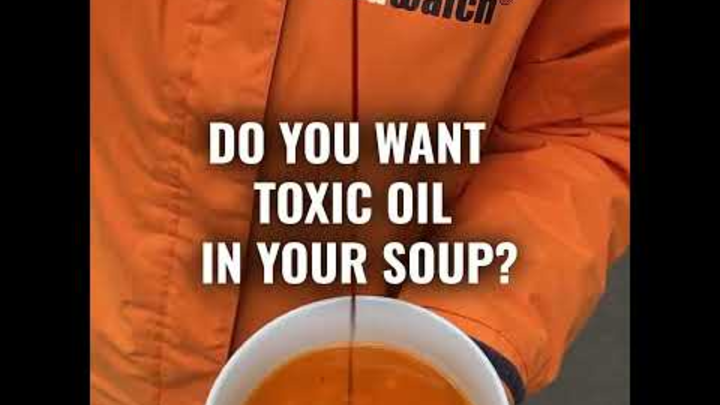Many common foods contain harmful mineral oil substances called MOSH and MOAH. These can build up in our bodies, and MOAH have even been associated with cancer causation. Despite over 12 years of campaigning, there are still no strict legally binding rules to protect consumers from these contaminants in our food.
Luckily, that is about to change! The Commission has finally drafted the regulation. It now needs to be agreed by a group of experts representing the 27 Member States in a committee and then be approved by the European Parliament.
By the end of 2024, legislation should be in place. But we need to keep pushing until we reach an acceptable finish line for consumer protection in this last chapter.
Are you curious about what has happened so far?
Let's start at the beginning! Some foodwatch campaigns can be predicted, and some are like our mineral oil campaign. When we launched it, we couldn't have known what we would set in motion - and the real-life impact it would have. One important takeaway lesson is that achieving real progress for consumer health protection requires a lot of patience.
End of 2012
The German testing platform “Stiftung Warentest” puts the chocolates in advent calendars under the microscope. Many of them contain harmful mineral oils. The source is the cardboard packaging: the recycled paper is contaminated with numerous chemical residues, including mineral oil-based colours. The European Food Safety Authority produces a “Scientific Opinion on Mineral Oil Hydrocarbons in Food” (EFSA, 2012): “Total MOAH should be monitored. Presently there is no suitable analytical method to separate different structural subclasses of MOAH. Analytical methods should be developed….”
At the time, there are no legal maximum levels for mineral oil content in food - not even in children's products.
2013
foodwatch receives a call from an industry insider who provides important background information on mineral oils in food. foodwatch familiarises itself with the topic, establishes contacts, attends specialist events and hold discussions with experts.
Autumn 2015
foodwatch offices in France, Germany and the Netherlands publish the first major international mineral oils’ test. We have 120 dry food products analysed - 43% contain the particularly dangerous "aromatic" mineral oils (MOAH), which are suspected of being carcinogenic and mutagenic. In Germany, Kellogg's cornflakes are one of the products contaminated.
Our demand to the EU Commission: Introduce limit values for these contaminants and legislate for "functional barriers" for all paper food packaging! Functional barriers are layers used to stop certain chemicals from food packaging from getting into the food.
The tests are making waves: More than 115,000 citizens from France, Germany and the Netherlands support the email protest campaign. As a result, the first manufacturers change their packaging and retail chains instruct their suppliers to avoid mineral oil contamination. But the hoped-for breakthrough - finally effective limit values - has not yet materialised. We are not discouraged; we organise additional product testing and we demand their recall.
October 2016
Still no response from the European Commission – we hand over our signatures to Commissioner Andriukaitis, then Commissioner for Health and Food Safety, but our demand for legislation remains unanswered.
January 2017
Finally, a response to our major test: the EU Commission announces a monitoring programme for mineral oils in food. Behind the scenes, experts are highly dissatisfied with the extensive standstill. They blame two players in particular: Nestlé and Danone, who cast doubt the validity of the analytical methods used by foodwatch.
April 2019
The Joint Research Committee (JRC) publishes the guidelines on analytical methods for monitoring Mineral Oil Hydrocarbons in food - there are now best practice guidelines for sampling and analysis: No more excuses for companies such as Nestle and Danone to resist the monitoring of mineral oils!
October 2019
foodwatch offices in Amsterdam, Berlin and Paris publish another major test: now on baby milk powder. Three laboratories with excellent references analyse the products independently of each other. We meticulously ensure that the test protocols used by the laboratories comply exactly with the JRC methodological guidelines.
The result is shocking: infant milk from Nestlé, Danone, Novalac, Neolac, Hero Baby and Nutrilon have been found to contain aromatic mineral oil components, which are suspected of causing cancer.
Then everything happens very quickly: one day later, the EU Commission informs all member states via its rapid alert system. While the phones in the foodwatch office are ringing off the hook with calls from worried parents, the companies continue to sell their products undisturbed. The milk powder is "absolutely safe", claims Nestlé.
November 2019
The European Food Safety Authority publishes its rapid risk assessment on our test. EFSA concluded that the exposure for infants and toddlers to MOAH in infant and follow-on formula is of possible concern for human health.
December 2019
At an ad-hoc expert meeting organised by the EU Commission, industry representatives are conspicuously meek. They have commissioned their own analyses to counter our tests.
However, the experts agree: it is only because of the use of incorrect methodologies that the industry laboratories have not found mineral oils’ residues. On the contrary, the validity of the foodwatch tests’ results is confirmed.
Beginning of 2020
German government laboratories also analyse infant milk - and find harmful mineral oils in products from Nestlé, Rossmann, Novalac and Humana. Instead of publicly recalling the products and warning parents, federal and state food ministries conceal the results. Apparently, it is more convenient to rely on Nestlé's "self-monitoring tests" than tackling the issue head-on.
It is only through a request under the Freedom of Information Act that foodwatch obtains the results of the state laboratories months later.
February 2020
A journalist from the Malaysian news agency Reuters states that Nestlé is exerting pressure on palm oil suppliers. They are asked to reduce the mineral oil residues in palm oil. Producers have allegedly spread palm kernels on hot asphalt surfaces and used non-food-grade machine lubricants. As a result, harmful crude oil compounds have seeped into the world's most widely consumed edible oil. It is now certain that the mineral oil contamination in baby milk mainly comes from palm oil. And foodwatch is convinced that Nestlé and Co. could - and should - have known this much earlier.
Beginning of 2020
German government laboratories also analyse infant milk - and find harmful mineral oils in products from Nestlé, Rossmann, Novalac and Humana. Instead of publicly recalling the products and warning parents, federal and state food ministries conceal the results. Apparently, it is more convenient to rely on Nestlé's "self-monitoring tests" than tackling the issue head-on.
It is only through a request under the Freedom of Information Act that foodwatch obtains the results of the state laboratories months later.
February 2020
A journalist from the Malaysian news agency Reuters states that Nestlé is exerting pressure on palm oil suppliers. They are asked to reduce the mineral oil residues in palm oil. Producers have allegedly spread palm kernels on hot asphalt surfaces and used non-food-grade machine lubricants. As a result, harmful crude oil compounds have seeped into the world's most widely consumed edible oil. It is now certain that the mineral oil contamination in baby milk mainly comes from palm oil. And foodwatch is convinced that Nestlé and Co. could - and should - have known this much earlier.
June 2020
The responsible expert committee of the EU Commission agrees on the use of a harmonised limit value for mineral oils for the first time. This is not yet strict enough and, above all, only applies to powdered baby milk. Nevertheless, we have come one step closer to our long-standing goal of a strict maximum level for hazardous mineral oils in all foods. foodwatch still needs to prove that mineral oils contamination is not only about infant milk formula.
September 2021
Although the health hazards from mineral oil impurities in food have been known for years, there are still no legal limits. foodwatch publishes the results of tests on 152 products from Austria, Belgium, France, Germany and the Netherlands, carried out by two different accredited laboratories: one in eight food products tested are contaminated. This means that seven out of eight products are not and that it is therefore possible to ensure foodstuffs are MOAH-free.
Since the publication of the test results in 2021, many of the companies concerned have responded. However, the responses show that the manufacturers do not see the responsibility for the problem lying with themselves and do not want to remove the contaminated products from the shelves.
It is clearer than ever that as long as there is no legally prescribed zero tolerance limit for MOAH, contaminated products will keep ending up on our plates.
If companies not willing to remove the foods from the shelves – then foodwatch will!
April 2022
In 2022 the Standing Committee on Plants, Animals, Food and Feed (PAFF Committee) agree on setting harmonised limits for aromatic mineral oils (MOAH), which are potentially carcinogenic and genotoxic. But the contamination levels are not yet strict enough to fully protect European consumers. There should be no detectable MOAH in any foodstuff in the European Union. With carcinogenic contaminants, even a small amount is too much.
October 2022
A clarification of the April decision by Member States experts is the best commitment that we have to work with until the legislation comes into place: Maximum Levels for ALL food categories, regardless of the source of MOAH, throughout the EU regarding “the sum of the concentrations of MOAH in food”.
2023
foodwatch speaks at industry events in Berlin – European Commission acknowledges foodwatch tests as being the driving force of the process towards the establishment of legally binding maximum levels for mineral oils in foodstuffs.

2024
Two years later the moment of decision is right upon us. The draft regulation is released, and the industry has had a chance to make comments – so did foodwatch of course!
The decisive PAFF meeting, where Member States decide on effective limit values, is scheduled for the summer. But there is a risk that the experts of the member states decide that maximum levels for MOAH come with exceptions, or long transition periods.
Now, more than ever, we need to mobilize and act. Sign our petition, so we can reach 100,000 signatures and show that consumers want safe foods without mineral oil contamination.
The fact that an NGO funded by citizens must drive the quality of laboratory analysis procedures speaks volumes about the current level of consumer protection in the EU. We must force food giants such as Nestlé and Danone to finally eliminate the health risks in their products that have been known for many years.
That’s why foodwatch is working towards an effective European Food Law. Right now, it doesn't protect consumers from unsafe food or fraud and lobbyists have too much influence over what we eat.
Sources and additional information
- Public report with all test results 2021
- Technical report 2021
- FAQ
- European Food Savety Authority (EFSA) on mineral oil in food
- JRC guidelines on data reporting for the monitoring of mineral oil in food 2020
- FAQ of foodwatch on mineral oil in baby milk 2020
- EFSA: Update of the risk assessment of mineral oil hydrocarbons in food, September 2023

